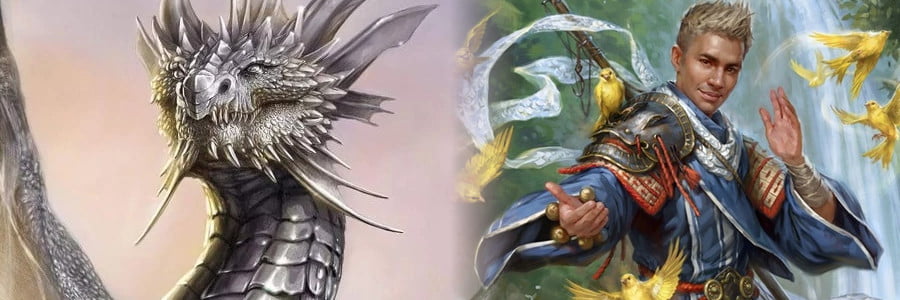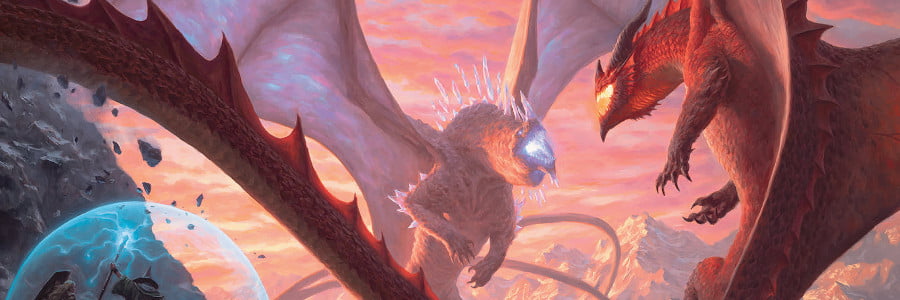Hey, answer in your own heart, but: Can dragons shapeshift?
Odds are good you break down into three basic categories of answer:
- Yes, of course
- No, why does anyone think that?
- No, they shouldn’t, and I’m mad at how many people think they do
And I guess, the fourth category
- Why do adults have firm opinions on this?

If you remember my concept I proposed a few years ago, that in the context of a fantasy universe, a dragon is a government, incarnated as an individual entity. They control large areas, people are under their purview, their presence can replace the danger of other kinds of lawlessness, and they are typically only toppled by things the dominant paradigm see as legitimate extensions of state power. You don’t see dragons being toppled by peasant uprisings, but you do see them being slain by individual knights.
What you also see, commonly enough, in the space that delves further into Dragons as agents in the world, is that dragons commonly take the forms of humans.
Before I go in on this, you may be able to bring this idea to your mind as a D&D thing, or possibly, a Warcraft thing. These two prominent franchises have both absolutely used the shapeshifting human dragon type all over the place, and it wouldn’t be hard to draw a line between one and the other,
Because there is a line,
And think ‘okay, it’s a D&D idea that Warcraft uses, and those two franchises are really influential to Gen X onwards,’ and that definitely could be a way those ideas proliferated on the internet. They’re not necessary, though, because there’s a lot of stories of dragons in the guise of humans doinking with humans from mythologies around the world, and lots of stories of ‘dragon humans.’ Like, to the extent I wasn’t even realising how common it was.
There’s the French folklore figure Melusine, the supposed forebear of French Royalty, is a mermaid figure who’s also depicted as a Dragon, depending on how cool you’re trying to make the French royalty look. There’s the humanoid dragons of the Tagarin in Russian myth, which I don’t know well enough to comment on at length. Greek myth includes both Typhon and the Scythian Dracaena, which were both ‘dragons’ that also had humanoid components, and mated with Echidna, who was half-human and half-serpent, depicted in a variety of ways, but crucially, they had faces and arms and hands. Also, Cadmus almost turned into a Dragon. In Eastern myths where I am far less familiar, there are figures like Shennong, who both was one of the first emperors of China, but also a sort of giga-chad mega-farmer who taught the Chinese people traditional medicine, and maybe had the head of a bull and his dad was a dragon. And this is just a short quick ‘hey, what shows up if I google myths of human-dragon hybrids’?

Now these aren’t universally one-direction things. If you look at most of these stories, they’re not the same kind of extensive vision of dragons turning into humans to interact with a human world the same way as you see in the more modern D&D and Warcraft stuff. It’s not unheard of, but it’s much rarer, and it seems to be more tied into ‘this cool king or dreadful enemy figure is a result of a human doinking a dragon (and how monstrous that is varies on if they’re a cool emperor or a horrible monster-person).’ This makes some sense, because while I say dragons are governments that’s not how they always were. Often, dragons were mysteries.
What does stand out, though, is how many of these dragons either changed shape or had human traits to start with, or wanted human traits. A lineage that leant you some element of the draconic made you seem important — the Spartoi (not Spartans) of Cadmus’ myth were made out of the teeth of dragons, and they’re meant to be the ancestors of the nobility of Thebes. The shapeshifting dragon interacting as a human, then, can be seen as continuing this lineage of ideas: That someone you interact with can claim some element of the dragon, that a dragon can exist in your everyday life as an agent.
This leads to the question that put me in mind of this whole conversation: What does an agent look like?
The dragon as a dragon is a powerful thing that can move at the scale of a government, able to rout armies, deform the land, change the course of rivers, knock over mountains, flatten forests and even create highways. But it’s also impersonal. How does a dragon with its big claw-y hands craft a ring for a human finger? How does a dragon write a book that a human can handle? When we want to confer the draconic onto objects it can be sometimes that the objects are made out of dragon like dragonscale armour or a dragon tooth sword, but those are violent exchanges.
When I said ‘dragons are governments,’ the joke that I added was ‘that you can fuck.’ And the dragon taking human form, to be a creature with agency, and hands and fingers and eyes and lips is part of that.